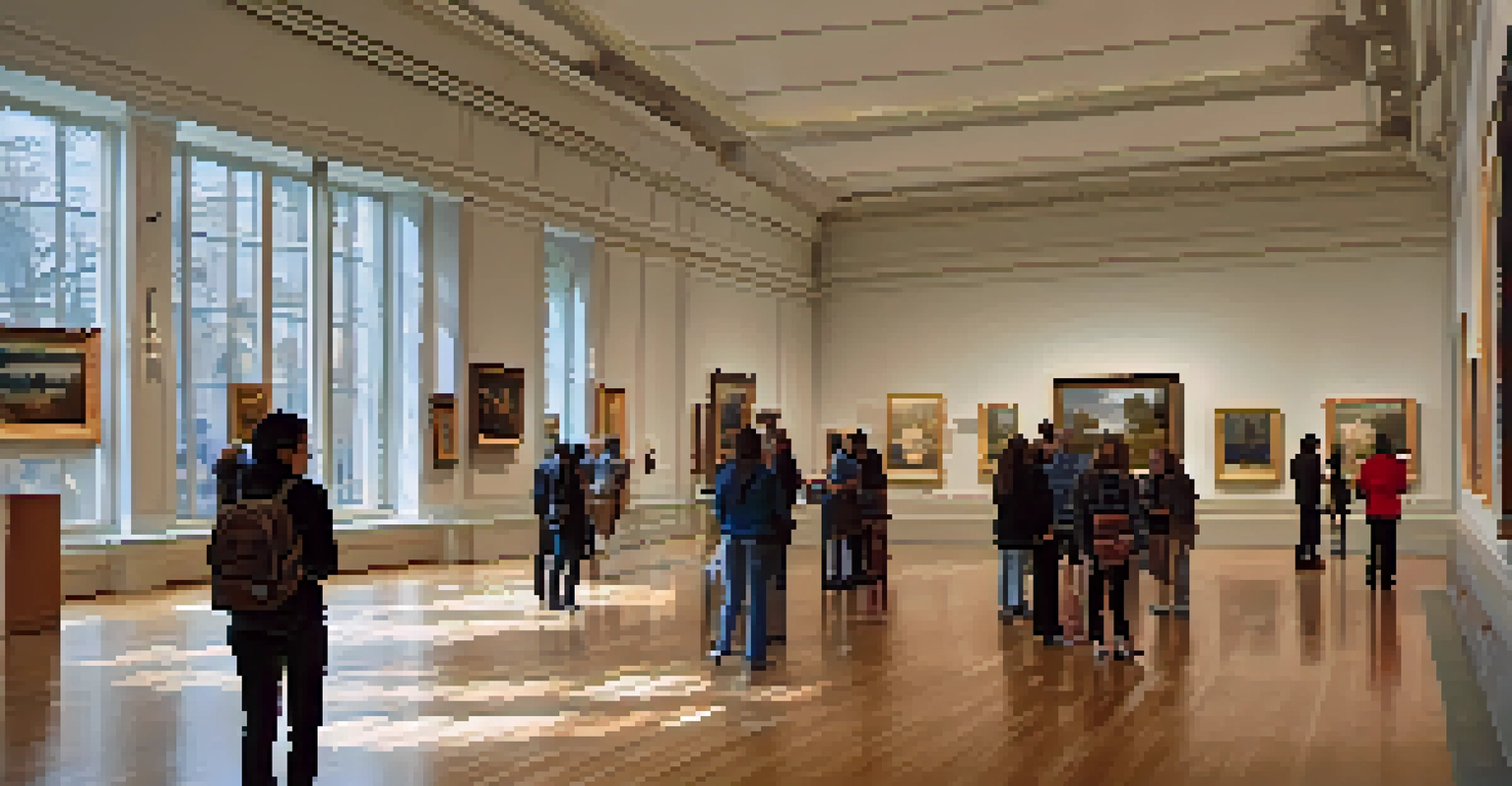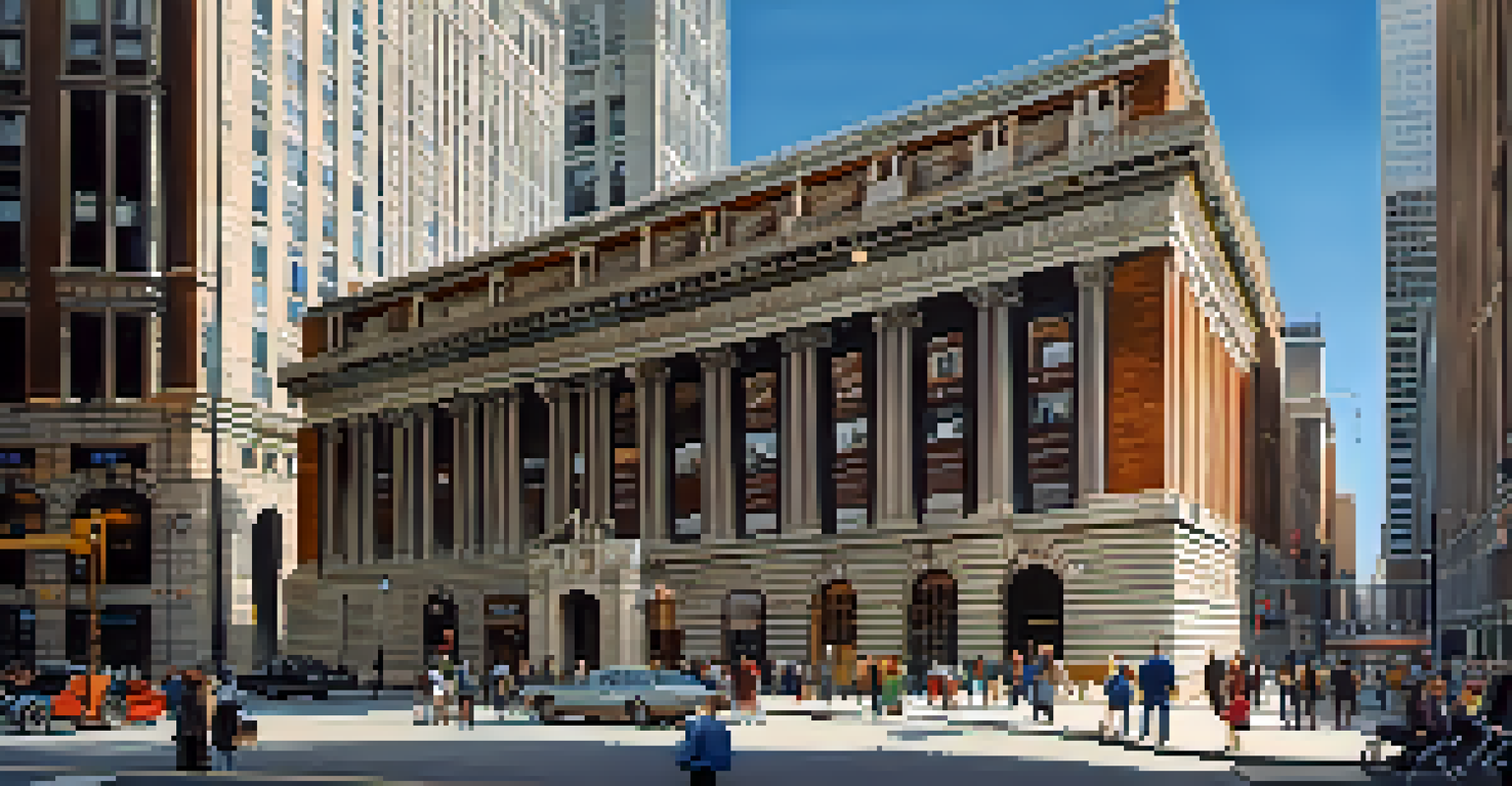Cultural Institutions in Chicago: Guardians of Heritage

The Role of Cultural Institutions in Chicago's Identity
Cultural institutions play a crucial role in shaping Chicago's identity. They serve as custodians of the city’s rich history, art, and traditions. From museums to theaters, these organizations not only preserve heritage but also actively engage the community in cultural dialogue.
Culture is the arts elevated to a set of beliefs.
By showcasing local artists and historical artifacts, these institutions create a sense of belonging for residents and visitors alike. They provide a platform for diverse voices and stories, reflecting the multifaceted nature of Chicago’s communities. This engagement fosters a deeper understanding of the city’s cultural fabric.
Moreover, cultural institutions contribute to the local economy by attracting tourists and creating jobs. They enhance the overall quality of life, making Chicago a vibrant place to live and explore. This interconnectedness of culture and community is what makes these institutions vital to the city.
Iconic Museums: Preserving Art and History
Chicago is home to some of the most iconic museums in the world, such as the Art Institute and the Field Museum. These institutions showcase an impressive collection of art and historical artifacts that tell the story of not just Chicago, but also humanity as a whole. Their vast offerings attract millions of visitors each year.

The Art Institute, for instance, is renowned for its Impressionist paintings, while the Field Museum houses ancient artifacts, including the famous Sue the T. rex. Both institutions engage in extensive educational programs, making art and history accessible to all. This approach ignites curiosity and fosters a love for learning.
Cultural Institutions Shape Identity
Cultural institutions in Chicago preserve heritage and foster community engagement, creating a shared sense of belonging.
Additionally, these museums often collaborate with local artists and historians to create dynamic exhibits that reflect contemporary issues. By bridging the past with the present, they ensure that the narrative of Chicago’s cultural heritage continues to evolve.
Theaters: A Stage for Performance and Expression
Chicago's theater scene is vibrant and diverse, offering a range of performances from Broadway shows to innovative local productions. Institutions like the Goodman Theatre and Steppenwolf Theatre Company have gained national recognition for their contributions to the performing arts. They provide a platform for both established and emerging artists to showcase their talents.
The past is never dead. It's not even past.
These theaters are not just about entertainment; they are also spaces for social commentary and cultural reflection. Through thought-provoking plays and performances, they address critical issues and challenge societal norms, encouraging audiences to engage in meaningful conversations. This ability to provoke thought is a testament to the power of performance art.
Moreover, many theaters offer outreach programs that aim to make the arts accessible to underserved communities. By providing affordable tickets and educational workshops, these institutions help cultivate the next generation of theater-goers and artists, ensuring the longevity of Chicago's rich cultural scene.
Libraries: Guardians of Knowledge and Community
Libraries in Chicago, like the Chicago Public Library, play a vital role in preserving and providing access to knowledge. They serve as community hubs where individuals can explore literature, history, and culture. Beyond books, libraries offer various programs that cater to different interests and age groups, fostering a love for learning.
These institutions also emphasize the importance of digital literacy in today's world. By providing access to technology and resources, they empower individuals to navigate the complexities of the information age. This commitment to education ensures that everyone in the community has the opportunity to thrive.
Museums and Theaters Drive Education
Iconic museums and theaters enhance public knowledge and appreciation for art and history through accessible educational programs.
Additionally, libraries often host cultural events, lectures, and workshops that celebrate local heritage. These initiatives not only enrich the community but also strengthen connections among residents, fostering a sense of unity and shared identity.
Cultural Festivals: Celebrating Diversity
Chicago is famous for its cultural festivals, which celebrate the city's rich diversity. Events like the Chicago Blues Festival and the Chicago Air and Water Show highlight the unique traditions and talents of various communities. These festivals provide an opportunity for residents and visitors to come together and honor Chicago’s cultural heritage.
Through music, dance, food, and art, cultural festivals create an immersive experience that showcases the vibrancy of the city. They encourage participation and foster understanding among different cultural groups, promoting inclusivity and appreciation of diversity. This celebration of heritage is a vital aspect of what makes Chicago special.
Moreover, these festivals often support local artists and businesses, contributing to the economy. By prioritizing local talent and resources, they help sustain the cultural ecosystem of the city, ensuring that the spirit of Chicago continues to thrive.
Historical Sites: Windows to the Past
Chicago is rich with historical sites that serve as windows to the past. Places like the Chicago History Museum and the Pullman National Monument provide insight into the city’s development and the stories of its inhabitants. These sites are essential for understanding the historical context of Chicago’s culture and identity.
Visiting these sites allows individuals to learn about significant events and figures that shaped the city. They offer guided tours, interactive exhibits, and educational resources that engage visitors of all ages. This focus on education helps to keep the history of Chicago alive and relevant.
Community Engagement is Essential
Active community involvement ensures Chicago's cultural landscape reflects diverse voices and strengthens local connections.
Further, many historical sites collaborate with cultural institutions and local organizations to host events that celebrate the city’s history. These partnerships not only enhance the visitor experience but also promote a collective appreciation for Chicago's heritage.
The Importance of Community Engagement
Community engagement is at the heart of Chicago's cultural institutions. These organizations strive to connect with residents through outreach programs, workshops, and collaborative projects. By involving the community, they ensure that the cultural landscape reflects the needs and interests of its diverse population.
Many institutions actively seek input from community members, allowing their voices to shape programming and initiatives. This collaborative approach fosters a sense of ownership and pride among residents, making them feel like active participants in the cultural dialogue. It also helps to address issues of representation and equity within the arts.

Ultimately, community engagement strengthens the bond between cultural institutions and the neighborhoods they serve. By prioritizing collaboration, these organizations create a more inclusive environment that encourages participation and celebrates the richness of Chicago’s cultural heritage.
Preserving Heritage for Future Generations
As guardians of heritage, Chicago's cultural institutions are dedicated to preserving the past for future generations. Their commitment to conservation and education ensures that the stories, art, and traditions of the city are not lost over time. This responsibility is vital for maintaining a connection to the city’s roots.
Through innovative programs and partnerships, these institutions are constantly finding new ways to engage younger audiences. By making history relevant and accessible, they inspire a sense of curiosity and appreciation for the cultural narrative of Chicago. This effort is crucial in fostering a love for heritage among future generations.
Moreover, as the city continues to evolve, cultural institutions adapt to reflect contemporary issues and trends. This dynamic approach not only honors the past but also embraces the future, ensuring that Chicago's heritage remains vibrant and relevant in an ever-changing world.